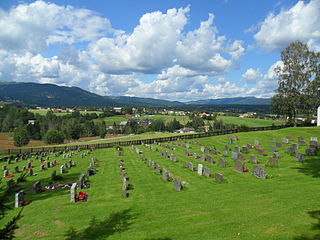
is a municipality in Telemark county, Norway. It is located in the traditional district of Grenland. The administrative centre of the municipality is the city of Porsgrunn. Some other notable settlements in Porsgrunn include the town of Brevik and the villages of Langangen and Heistad.

is a municipality in Innlandet county, Norway. It is located in the traditional district of Gudbrandsdal. The administrative centre of the municipality is the village of Vålebru.

Søndre Land is a municipality in Innlandet county, Norway. It is located in the traditional district of Land. The administrative centre of the municipality is the village of Hov. Other villages in the municipality include Fluberg and Odnes.

Lardal is a former municipality in Vestfold county, Norway. The 278-square-kilometre (107 sq mi) municipality existed from 1838 until its dissolution in 2018. The area is now part of Larvik Municipality. The administrative centre was the village of Svarstad. The village of Steinsholt was also part of Lardal.

Siljan is a municipality in Telemark county, Norway. It is located in the traditional district of Grenland. The administrative centre of the municipality is the village of Siljan. Other villages in Siljan include Snurråsen and Øverbø.

Fyresdal is a municipality in Telemark county, Norway. It is located in the traditional district of Vest-Telemark. The administrative centre of the municipality is the village of Moland. Other villages in Fyresdal include Kilegrend, Øvre Birtedalen, and Øyane.

Hjartdal is a municipality in Telemark county, Norway. It is located in the traditional district of Upper Telemark and Aust-Telemark. The administrative centre of the municipality is the village of Sauland. Other villages in the municipality include Tuddal and Hjartdalsbygda.

Tokke is a municipality in Telemark county, Norway. It is located in the traditional district of Vest-Telemark. The administrative centre of the municipality is the village of Dalen. Other villages in Tokke include Åmdals Verk, Eidsborg, Høydalsmo, Lårdal, and Øvre Byrte. The Eidsborg Stave Church is one of Norway's old stave churches and it is located in Eidsborg, just north of Dalen.

Kviteseid is a municipality in Telemark county, Norway. It is located in the traditional districts of Vest-Telemark and Upper Telemark. The administrative centre of the municipality is the village of Kviteseidbyen. Other villages in Kviteseid include Åsgrend, Brunkeberg, Eidstod, Fjågesund, Kilen, Morgedal, and Vrådal.

Seljord is a municipality in Telemark county, Norway. It is located in the traditional districts of Upper Telemark and Vest-Telemark. The administrative centre of the municipality is the village of Seljord. Other villages in the municipality include Flatdal and Åmotsdal.

Vinje is a municipality in Telemark county, Norway. It is located in the traditional district of Vest-Telemark which is part of Øvre Telemark. The administrative centre of the municipality is the village of Åmot. Other villages in the municipality include Arabygdi, Edland, Grunge, Haukeli, Krossen, Møsstrond, Nesland, Øyfjell, Raulandsgrend, and Vinje.

Drangedal is a municipality in Telemark county, Norway. It is located in the traditional district of Grenland. The administrative centre of the municipality is the village of Prestestranda. Other villages in Drangedal include Bø i Tørdal, Bostrak, Gautefall, Henseid, and Neslandsvatn.

Sauherad is a former municipality in Telemark county, Norway. It was part of the traditional region of Midt-Telemark. The 321-square-kilometre (124 sq mi) municipality existed from 1838 until its dissolution in 2020. The area is now part of Midt-Telemark Municipality and Notodden Municipality. The administrative centre was the village of Akkerhaugen. Other villages in the municipality included Gvarv, Holtsås, Hjukse, Hjuksebø, Nordagutu, and Sauherad. Sauherad bordered the municipalities of Kongsberg, Skien, Nome, Bø, and Notodden.

Bø is a former municipality in Telemark county, Norway. It was part of the traditional region of Midt-Telemark, but was historically regarded as part of Grenland. The 263-square-kilometre (102 sq mi) municipality existed from 1838 until its dissolution in 2020. The area is now part of Midt-Telemark Municipality. The administrative centre was the village of Bø i Telemark. Other villages in the municipality included Folkestad and Nordbøåsane.

is a municipality in Telemark county, Norway. It is located in the traditional district of Aust-Telemark. The administrative centre of the municipality is the town of Notodden. Other population centres include the villages of Bolkesjø, Gransherad, Heddal, Hjuksebø, Hjuksevelta, Rudsgrendi, Tinnoset, and Yli.

Bamble is a municipality in Telemark county, Norway. It is located in the traditional district of Grenland. The administrative centre of the municipality is the town of Langesund. Other population centres in Bamble include the town of Stathelle and the villages of Bamble, Botten, Herre, and Valle.

Tinn is a municipality in Telemark county, Norway. It is located in the traditional districts of Aust-Telemark and Upper Telemark. The administrative centre of the municipality is the town of Rjukan. Some of the villages in Tinn include Atrå, Austbygde, Hovin, and Miland.

Bygland is a municipality in Agder county, Norway. It is located in the traditional district of Setesdal. The administrative centre of the municipality is the village of Bygland. Other villages in the municipality include Åraksbø, Austad, Byglandsfjord, Grendi, Langeid, Lauvdal, Litveit, Longerak, Moi, Ose, Sandnes, Skåmedal, and Tveit. The Norwegian National Road 9 runs through the municipality, following the river Otra where most of the population of Bygland lives.

Nome is a municipality in Telemark county, Norway. It is located in the traditional district of Midt-Telemark and historically part of the Grenland region. The administrative centre of the municipality is the village of Ulefoss. Other villages include Bjervamoen, Ulefoss, Helgja, Flåbygd, and Svenseid.

is a former municipality in Vestfold county, Norway. The 58-square-kilometre (22 sq mi) municipality existed from 1845 until its dissolution in 2020. The area is now part of Drammen Municipality in Buskerud county. The administrative centre was the town of Svelvik. The other population centres in Svelvik included Nesbygda and Berger.





























